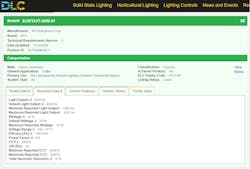Do Field-Adjustable LED Fixtures Qualify for Rebates?
Over the past couple of years, LED manufacturers have introduced field-adjustable LED fixtures into the market. They are different from the traditional controllable/dimmable fixtures most people are familiar with; rather than the user dynamically adjusting the light level or color temperature, these field-adjustable fixtures are typically set once during installation and left that way. Because of the growth of this category of LED products, BriteSwitch, a firm specializing in capturing local, utility, state, and federal rebates/incentives for businesses, looked into how rebate programs treat them.
What are field-adjustable LED fixtures?
Field-adjustable fixtures are LED products where the installer can set a specific light output, wattage, or color temperature on site. These fixtures typically have a DIP switch or jumper on them to customize the light.
In 2018, the Design Lights Consortium (DLC) started qualifying fixtures that are field-adjustable. These types of LED solutions currently represent less than 10% of the results on the DLC list, but it is a rapidly growing segment.
They typically fall into three categories:
- Field-adjustable light output fixture (FALO). The fixture's wattage and light output can be adjusted.
- White-tuneable. The color temperature (CCT) of the fixture can be adjusted. This category doesn't include RGB or color-changing LEDs; it's limited to different color temperatures of white (2,200K to 6,500K).
- Field-adjustable light distribution (FALD). The light distribution of the lamps, retrofit kits, or fixtures can be adjusted. An example is a troffer that is shipped with three different reflectors, and the installer chooses which one to use.
A single product can use a combination of these technologies, so the user might be able to select the lumen output and color temperature in one SKU. The product categories with the most field-adjustable models on the current DLC list are pole/arm-mounted fixtures (37%), high bays (21%), and troffers (12%). Another popular category is field-adjustable downlights, which are certified by Energy Star, rather than DLC.
What is the benefit of field-adjustable fixtures?
Imagine you're a distributor who stocks troffer fixtures in a warehouse. You might have one SKU to replace a two-lamp T8 fixture, one for a three-lamp fixture, and one for a four-lamp fixture. Then you would need some of the main color temperatures: 3,000K, 4,000K, and 5,000K. That totals nine different SKUs you must stock with just one brand. Field-adjustable fixtures make it easier to stock just one fixture and sell it to many types of customers.
Although these fixtures aren't typically user-adjustable, they provide some additional flexibility for the customer. They don't have to worry about picking the right lumen output or color temperature right away; the customer can wait until the fixtures are being installed and have it adjusted at that point based on how it actually looks in the space.
Do field-adjustable fixtures qualify for LED rebates?
For the most part, if a standard fixture will qualify for a rebate, then its field-adjustable counterpart would also be eligible. Like traditional fixtures, a vast majority of rebate programs require the fixtures to be DLC- or Energy Star-rated to get a rebate. As of today, we have not seen any rebate program that expressly excludes field-adjustable fixtures.
How are field-adjustable fixture rebates different?
In areas with a prescriptive rebate amount paid on a “per fixture” basis, the rebate for a field-adjustable fixture would be the same in almost all cases.
Where the rebates will differ is for programs that base their incentives on watts or kilowatts saved. Below, you'll see the DLC listing for a field-adjustable LED troffer. The DLC listing shows the reported wattage, the default wattage the fixture will use out of the box, and the maximum wattage. This specific fixture can operate at 25W, 30W, or 34W. If the customer is using the fixture at the 25W setting, how will the rebate program treat it?
We've reached out to some of the major rebate programs in North America to get their take on it. The responses varied widely. Some programs, like Focus on Energy in Wisconsin, will consider a lower wattage if you can take a picture of the DIP switch and provide a signed affidavit. Others will only use the wattage listed on the DLC listing.
What kind of rebate can field-adjustable LED fixtures receive?
Below, you'll see the current average rebates for the main field-adjustable fixture categories across the United States.
How can I get rebates for field-adjustable LED fixtures?
Because each rebate program can treat field-adjustable fixtures differently, it's essential to do your homework before committing to a specific product. This step is even more critical if you're planning to use a field-adjustable fixture at one of its lower wattages. For the 2×4 troffer mentioned above, if the fixture is at the lowest setting of 25W (but the utility only accepts the maximum wattage of 34W), the fixture would get a 25% less rebate than it should if the incentive is on a watt saved or kWh saved basis.
While you can reach out to a rebate program in the early stages of a project, the safest way to ensure eligibility is to file for pre-approval. Most commercial lighting rebate programs require pre-approval before installation anyway, so this step offers the perfect opportunity to see how the program will treat the fixture you want to use.
Randy Young is the operations manager at BriteSwitch, a company that specializes in finding and capturing rebates for businesses. He can be reached at [email protected].
About the Author
Randy Young
Director of Marketing and Data Solutions
Randy Young is the director of marketing and data solutions at BriteSwitch, a company that specializes in finding and capturing rebates for businesses. He can be reached at [email protected].


